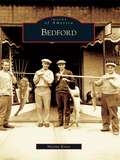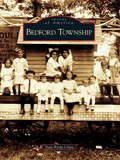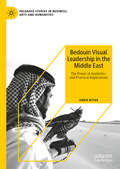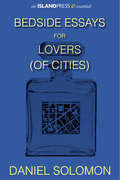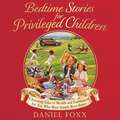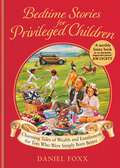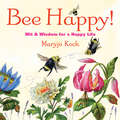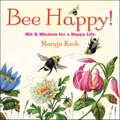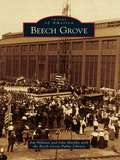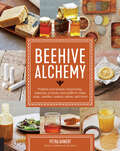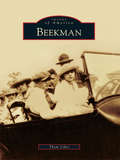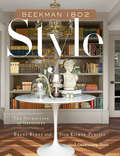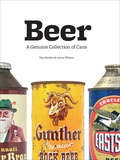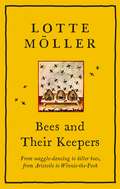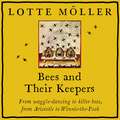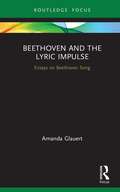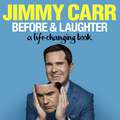- Table View
- List View
Bedford
by Maxine KruseThe county seat of Lawrence County, Bedford is in the heart of Indiana's limestone belt and is known as the "Limestone Capital of the World." Famous buildings across the nation, including the Pentagon, the Empire State Building, and the National Cathedral, feature limestone quarried and carved in Bedford. After faltering between the Depression and World War II, the limestone industry is still going strong. Today, during the early spring when the dogwood and redbud trees are in bloom, the area is particularly scenic, and tourists flock to the rolling hills of Bedford and nearby Spring Mill State Park. Through archival photographs and historic ephemera, Bedford captures the birth of a classic Midwestern quarry town and its growth into a thriving modern community.
Bedford Township (Images of America)
by Trudy Wieske UrbaniLocated in southeast Michigan, Bedford Township is Toledo, Ohio's largest suburb. It has been widely recognized as the garden spot of Monroe County and is a great place to raise children. Emerging out of Erie Township in 1836, Bedford Township grew from a group of 60 pioneering families, many of whom still have descendants in the area. Bedford encompasses the three unincorporated villages of Lambertville, Samaria, and Temperance. All have developed a strong sense of local pride, manifested in various annual events including homecomings, trade fairs, and school and family reunions. Bedfordians who have achieved wide recognition include ballplayer LeRoy "Bud" Parmelee, "Brighten the Corner" hymnist Ina Duley Ogdon, bus safety-mirror inventor Reid Stout, artist Howard J. Schuler, World War II hero Ensign Harry Lee Corl, and Sens. Norm Shinkle and Bev Hammerstrom. We invite you to browse these pages, noting family names--if your friends or relatives are mentioned, enjoy renewed acquaintances. Next time you are back home check out our Local History Room in the grand new Bedford Branch of the Monroe County Library, where you may find your ancestors on the shelves.
Bedouin Visual Leadership in the Middle East: The Power of Aesthetics and Practical Implications (Palgrave Studies in Business, Arts and Humanities)
by Amer BitarThis book focuses on leadership as a visual discourse and explores the construction of this discourse within the context of Bedouin Arabia, and the Middle East more broadly. In it, the author considers business and organisational leadership from an aesthetic perspective and in the context of various geographical and historical settings. The book examines the work of a variety of artists, and examines how public representations of business and political figures are used as a tool of leadership. Using a Foucauldian perspective, the book explores the interconnected concepts of power and knowledge, examining how visual images are used in the Middle Eastern context for leaders to communicate with their followers and the public. The Bedouin business world provides a unique opportunity for the researcher to examine the interplay between culture, management and politics. The book will be of interest to academics working in the fields of aesthetics, leadership, management, culture, and the Middle East more broadly.
Bedside Essays for Lovers (Island Press E-ssentials)
by Daniel SolomonIn this provocative collection of essays, renowned architect Daniel Solomon delves into the complexities of what makes a city vibrant. Acknowledging that a city is not a static thing, he argues we need to pay more attention to nurturing what he calls "continuous cities." In such a city, he says, "new buildings, new institutions, and new technologies don't rip apart the old and wreck it. They accommodate, they act with respect, and they add vibrant new chapters to history without eradicating it." Continuity, he explains, is the way to promote sustainability-- and contrary to what the advocates of "modern architecture" claim, he insists that honoring the traditional ways of city building still provides a solid foundation for places to grow, evolve, be modern. However fond you are of your city, or however much you feel it needs improvement, this short collection of essays offers an enticing vision of the future. All of our cities have a past worth examining, a richness of experience that can shape the future in wonderful, surprising ways. Solomon's prose is thought-provoking and inspiring, well worth keeping close by wherever you do your reading--be it your bedside, couch, a park, or on the metro.
Bedtime Stories for Privileged Children: Charming Tales of Wealth and Entitlement for Tots Who Were Simply Born Better
by Daniel Foxx'As if Succession was turned into a series of Ladybird books' - THE TIMES'A terribly funny book from an absolutely disgraceful person' -JOE LYCETT'Daniel's writing is hilarious, although it makes me worry about how I'm bringing my children up' - JOSH WIDDICOMBE'Finally! Some stories to shut those little brats up who disturb me at brunch!' -TOM ALLENAuthor and comedian Daniel Foxx presents a wonderful collection of stories especially for the little darlings of the fabulously wealthy - that can also be enjoyed by YOU, the downtrodden, pitiful, ordinary adult!Read about the everyday adventures of Rupert, Shallotte and Genevievette as they ski, holiday, and drift around Selfridges - whilst always keeping a healthy distance from the dreaded hoi polloi!Other magical adventures include:Rupert goes on holiday! But what is 'duty free'? And why do poor people love it so much?Cosmo goes to state school, where the teachers wear jeans and no-one can understand Latin!Lily goes with Daddy to work! And fires Kate from marketing!!BEDTIME STORIES FOR PRIVILEGED CHILDREN is the perfect Christmas gift - whether you're wintering in Aspen, summering in Tuscany, or simply want to keep the little ones quiet in the back of the Range Rover Evoque.***Contains adult language
Bedtime Stories for Privileged Children: Charming Tales of Wealth and Entitlement for Tots Who Were Simply Born Better
by Daniel Foxx'A terribly funny book from an absolutely disgraceful person' -JOE LYCETT'Daniel's writing is hilarious, although it makes me worry about how I'm bringing my children up' - JOSH WIDDICOMBE'Finally! Some stories to shut those little brats up who disturb me at brunch!' -TOM ALLENAuthor and comedian Daniel Foxx presents a wonderful collection of stories especially for the little darlings of the fabulously wealthy - that can also be enjoyed by YOU, the downtrodden, pitiful, ordinary adult!Read about the everyday adventures of Rupert, Shallotte and Genevievette as they ski, holiday, and drift around Selfridges - whilst always keeping a healthy distance from the dreaded hoi polloi!Other magical adventures include:Rupert goes on holiday! But what is 'duty free'? And why do poor people love it so much?Cosmo goes to state school, where the teachers wear jeans and no-one can understand Latin!Lily goes with Daddy to work! And fires Kate from marketing!!BEDTIME STORIES FOR PRIVILEGED CHILDREN is the perfect Christmas gift - whether you're wintering in Aspen, summering in Tuscany, or simply want to keep the little ones quiet in the back of the Range Rover Evoque.***Contains adult language
Bedtime Stories for Privileged Children: Charming Tales of Wealth and Entitlement for Tots Who Were Simply Born Better
by Daniel Foxx'A terribly funny book from an absolutely disgraceful person' -JOE LYCETT'Daniel's writing is hilarious, although it makes me worry about how I'm bringing my children up' - JOSH WIDDICOMBE'Finally! Some stories to shut those little brats up who disturb me at brunch!' -TOM ALLENAuthor and comedian Daniel Foxx presents a wonderful collection of stories especially for the little darlings of the fabulously wealthy - that can also be enjoyed by YOU, the downtrodden, pitiful, ordinary adult!Read about the everyday adventures of Rupert, Shallotte and Genevievette as they ski, holiday, and drift around Selfridges - whilst always keeping a healthy distance from the dreaded hoi polloi!Other magical adventures include:Rupert goes on holiday! But what is 'duty free'? And why do poor people love it so much?Cosmo goes to state school, where the teachers wear jeans and no-one can understand Latin!Lily goes with Daddy to work! And fires Kate from marketing!!BEDTIME STORIES FOR PRIVILEGED CHILDREN is the perfect Christmas gift - whether you're wintering in Aspen, summering in Tuscany, or simply want to keep the little ones quiet in the back of the Range Rover Evoque.***Contains adult language
Bee Happy!: Wit & Wisdom for a Happy Life
by Maryjo KochA thoughtful gift for grads, moms, friends, anyone heading down a new path, Bee Happy shares wit and wisdom for happiness in a naturally giftable package.
Bee Happy!: Wit & Wisdom for a Happy Life
by Maryjo KochA thoughtful gift for grads, moms, friends, anyone heading down a new path, Bee Happy shares wit and wisdom for happiness in a naturally giftable package.
Beech Grove
by John Murphy Jim Hillman Beech Grove Public LibraryEarly-20th-century Indianapolis was developing into a major transportation center. The extension of rail lines operated by the "Big Four Railroad," the Cleveland, Chicago, Cincinnati, and St. Louis Railway, invaded farmland 5 miles southeast of the busy Indianapolis Union Station. By 1904, the native beech trees neighbored the construction of the Big Four Shops, a facility charged with the production of steam locomotives. The shops brought jobs, an immediate draw for commercial and residential development, culminating in 1906 when the unnamed, adjacent community incorporated as the town of Beech Grove. A century later, the city of Indianapolis has grown to entirely surround the vibrant community, yet Beech Grove retains its small town atmosphere. Anchored by a vibrant Main Street, the charm of Beech Grove is found within quiet residential neighborhoods, distinguished schools, diverse churches, and major employers, including Amtrak and St. Francis Hospital.
Beech Mountain
by Beech Mountain Historical SocietyBeech Mountain was once a rugged wilderness known only to the Cherokee Indians. Eventually hunters, loggers, moonshiners, and settlers made their marks upon the mountain. In the 1960s, Tom Brigham, a Birmingham dentist, envisioned a ski resort in the South and chose Beech Mountain as the perfect site. Grover Robbins, a timber man and developer from Blowing Rock, turned Brigham's vision into the Carolina Caribbean Corporation, which developed a four-season resort with the Land of Oz at the top. Initially lots sold faster than roads could be built to reach them, and the overextended company went bankrupt. Property owners rallied to preserve what had been created, and in 1981, the mountain reinvented itself as a charming town and popular resort destination. In addition to a core of permanent residents, it draws thousands of visitors annually for skiing, hiking, spectacular scenery, cool summers, and excellent golf, tennis, and other recreational facilities--and for the special feeling that is Beech Mountain.
Beehive Alchemy: Projects and Recipes Using Honey, Beeswax, Propolis, and Pollen to Make Soap, Candles, Creams, Salves, and More
by Petra AhnertA comprehensive introduction to making candles, home and body products life from the author of Beeswax Alchemy.Beehive Alchemy is a continuation of Petra Ahnert’s bestselling Beeswax Alchemy. With this new book, beekeepers (and bee lovers) will learn about the benefits and attributes of beeswax, honey, propolis, and more alongside a full range of projects and techniques to process and harness the amazing gifts of bees. Inside, you’ll find instructions to make Ahnert’s award-winning hand-dipped birthday candles, the classic French dessert canele bordelais, and much more, including:Alchemy for the BodyLiquid soap with honeyBeard balmOlive and honey lotionAlchemy of LightTaper candlesTea lightsPillarsAlchemy for the HomeFurniture polishWaxed cotton food wrapsWoodcutter incenseAlchemy in the StudioBeeswax crayonsEncausticBatikAlchemy in the KitchenCookies and candiesBeveragesFermentationsWhether you keep bees or just love them, Beehive Alchemy will become your go-to comprehensive guide for hive-to-home creations.Praise for Beeswax Alchemy:“An excellent introduction and solid technique instruction to make candles, lotions, and soaps with beeswax. . . . The true strength of this book is its instructions for making homemade body products. While similar in coverage to Leeann Coleman and Jayne Barnes’s Honey Crafting, Ahnert’s book provides better body products and more detailed technical instruction. Strongly recommended.” —Library Journal“This is the book I’ve been waiting for. Excellent instructions. Bountiful information. Beautifully done.” —Kim Flottum, author of The Backyard Beekeeper and editor of Bee Culture magazine
Beekeeper's Lab: 52 Family-Friendly Activities and Experiments Exploring the Life of the Hive
by Kim Lehman"Very informative and fun . . . Science, art, bee care, 52 different labs to entertain, delight, educate and inspire everyone in your family." —A Net in TimeBeekeeping's popularity as a hobby continues to skyrocket. And now, with Beekeeper's Lab, you can fill the year ahead with weekly activities from around and about the hive—including art projects, recipes, experiments, garden activities, and more!Bees are important to local ecosystems,now more than ever. Whether you're already a beekeeper, or are still considering getting your first hive, Beekeeper's Lab has projects perfect for you. This extensive guide book features 52 beekeeping and hive-inspired projects to keep you involved with your buzzing friends all year long.The tutorials are brief, accomplishable, rewarding, and best of all, they are presented in afriendly lab-style format. Try a new technique each weekwith how-tos and sidebars with tips that are perfect for the whole family. Beekeeping is a fun hobby to enjoy, plus, who doesn't want their own supply of honey?
Beekman (Images of America)
by Thom UsherIn the latter half of the 19th century, the town of Beekman experienced an industrial boom. Iron ore beds were discovered in the hamlets of Sylvan Lake, Beekman, and Clove Valley. Mining boomed until the 1890s, and many of the small ponds scattered about town today were originally open ore pits. The mining industry brought the railroad and a second influx of immigrants, mostly from Ireland. The arrival of these immigrant families created an entirely new culture in the town. In 1911, an 839-acre site in the hamlet of Green Haven was acquired by the state. Camp Whitman opened there in 1915 and was used for training soldiers in preparation for the invasion of Mexico and pursuit of Pancho Villa.
Beekman 1802 Style: The Attraction of Opposites
by Josh Kilmer-Purcell Brent RidgeYou can't help what objects you fall in love with. But can you make that trendy new lamp jibe with your grandmother's heirloom dresser? The fabulous Beekman Boys answer with a resounding "Yes!" in their new book, Beekman 1802 Style. Through more than 200 stunning photographs from Country Living magazine and never-before-seen images of the Beekman farmhouse, the boys use their city-turned-country-boy charm and style to help with all things home. Their unique home design tips and tricks for mixing high and low, East and West, indoors and outdoors, and traditional with modern will help you create a home that is inviting, warm, and--perhaps most important--fabulous.
Beer Games: A Hilarious Collection of Drinking Games, Challenges and Dares
by Summersdale PublishersIt's time to take beer drinking to the next level? These outrageous challenges, hilarious dares and awesome drinking games will make beer drinking even better than it was before.A good session will never be the same. Rise to the challenge, if you dare…
Beer Games: A Hilarious Collection of Drinking Games, Challenges and Dares
by Summersdale PublishersIt's time to take beer drinking to the next level? These outrageous challenges, hilarious dares and awesome drinking games will make beer drinking even better than it was before.A good session will never be the same. Rise to the challenge, if you dare…
Beer: A Genuine Collection of Cans
by Dan Becker Lance Wilson&“Lends some insight into the evolution of beer can design and the changing conversation with the consumer through its 500 images.&” —Cool Hunting Ever crack open a can of Chief Oshkosh of Wisconsin, or sample Pabst&’s Big Cat Malt Liquor? Remember the original St. Pauli Girl, Tennent&’s bevy of lager lovelies, or Olde Frothingslosh (&“the pale stale ale with the foam on the bottom&”)? Presented alphabetically by brand, the nearly 500 cans collected here come from thirty countries and range from the iconic to the obscure to the downright bizarre. From long-forgotten brews to classic brands that have changed their look but never gone out of style, Beer offers a peek into the last century of beer culture, exploring what we drank, how we drank it, and why we picked it off the shelf. While it may not be as refreshing as a frosty cold can of Bud, cracking open this book is certain to stimulate beer lovers and design fans alike. &“A great look back at the history of beer design and advertising throughout the last century. I&’m sure most beer lovers could appreciate this particular book.&” —PhillyBurbs &“From the deliciously ephemeral Schmidt&’s City Club, to the ambiguous &‘Lite Beer&’—the collection will have you saying, &‘Who the hell ever drank that?&’ and perhaps, &‘What the hell was I thinking in college?&’&” —Foodiggity
Bees and Their Keepers: From waggle-dancing to killer bees, from Aristotle to Winnie-the-Pooh
by Lotte MöllerA beautifully illustrated and thoroughly engaging cultural history of beekeeping - packed with anecdote, humour and enriching historical detail. The perfect gift."A charming look at the history of beekeeping, from myth and folklore to our practical relationship with bees" Gardens Illustrated"An entertaining collation of bee trivia across the millennia" Daily Telegraph* Sweden's Gardening Book of the Year 2019 * Shortlisted for the August Prize 2019 * Winner of the Swedish Book Design Award for 2019Beekeeper and garden historian Lotte Möller explores the activities inside and outside the hive while charting the bees' natural order and habits. With a light touch she uses her encyclopaedic knowledge of the subject to shed light on humanity's understanding of bees and bee lore from antiquity to the present. A humorous debunking of the myths that have held for centuries is matched by a wry exploration of how and when they were replaced by fact. In her travels Möller encounters a trigger-happy Californian beekeeper raging against both killer bees and bee politics, warring beekeepers on the Danish island of Læso, and Brother Adam of Buckfast Abbey, breeder of the Buckfast queen now popular throughout Europe and beyond, as well a host of others as passionate as she about the complex world of apiculture both past and present.Translated from the Swedish by Frank Perry
Bees and Their Keepers: From waggle-dancing to killer bees, from Aristotle to Winnie-the-Pooh
by Lotte MöllerWith deep knowledge and a sharp wit, Lotte Möller unfolds our understanding of bees and bee lore from antiquity to the present. A beekeeper herself, she gives insight into the activity in the hive and describes the bees' natural order and habits. She explores the myths of the past, and how and when they were replaced by fact. For example, the heated discussions that broke out in the eighteenth century when it was discovered that the hive was ruled by a queen, not a king as had been the belief since Aristotle. In her travels Möller encounters a host of colourful characters, from a trigger-happy Californian beekeeper raging against both killer bees and bee politics, to the warring beekeepers on the island of Læso and Brother Adam of Buckfast Abbey, breeder of the Buckfast queen now popular throughout Europe and beyond. Bees and Their Keepers is a compelling cultural history for the beekeeper and general reader alike.Translated from the Swedish by Frank Perry(P)2020 Quercus Editions Limited
Beeswax Alchemy: How To Make Your Own Soap, Candles, Balms, Creams, And Salves From The Hive
by Petra Ahnert<p>Modern beekeepers - take notice! Here we have the answer to one of the most common questions related to beekeeping: what do I do with all of this beeswax? <p>In fact, the possibilities are seemingly endless! Since beeswax has multiple holistic and decorative uses, projects can vary from beeswax balms and beeswax creams, to household items like the classic beeswax candle. Beeswax Alchemy is your first step towards using excess beeswax to make beautiful, wellness boosting gifts for friends, family, and even yourself. <p>Not a beekeeper? Don’t worry, this guide works just as well with store bought beeswax! <p>The DIY beeswax projects are almost never ending, so grab some beeswax and get fired up!</p>
Beeswax Alchemy: How to Make Your Own Candles, Soap, Balms, Salves, and Home Décor from the Hive
by Petra Ahnert“Provides an excellent introduction and solid technique instruction to make candles, lotions, and soaps with beeswax. Strongly recommended.” —Library JournalFeaturing over forty DIY projects that illustrate how to transform one of the world’s most natural ingredients into tangible creations, Beeswax Alchemy is the perfect amalgamation of recipe craft book and beekeepers’ guide.Considered the miracle of the beehive and used by humans for 8,000 years, beeswax remains a vital ingredient and is still used as the foundation for many household products in the twenty-first century. Learn from apiarist and entrepreneur Petra Ahnert about the history of beeswax, as well as tips and techniques on how to mold it into beautiful, reusable creations.You’ll also find an explanation of the different types of beeswax, as well as insider tips on working with beeswax, followed by step-by-step instructions for making candles, balms, salves, creams, scrubs, soaps, ornaments, art, and more out of beeswax (either your own or store-bought). Color photos illustrate the processes. Among the useful and beautiful things you’ll learn to make out of beeswax:Hand-Dipped Birthday CandlesLip Balm with Cocoa ButterRosebud SalveSolid Natural PerfumesHoney, Oats, and Beeswax SoapBeeswax LuminariesWhether you are an expert beekeeper or experimental crafter, Beeswax Alchemy is the best guide for anyone aspiring to make wellness-boosting treasures to keep or gift to friends and family. “This is the book I’ve been waiting for. Excellent instructions. Bountiful information. Beautifully done.” —Kim Flottum, author of The Backyard Beekeeper and editor of Bee Culture magazine
Beeswing: Losing My Way and Finding My Voice 1967-1975
by Richard ThompsonAn intimate look at the early years of one of the world&’s most significant and influential guitarists and songwriters. In this moving and immersive memoir, Richard Thompson, international and longtime beloved music legend, recreates the spirit of the 1960s, where he found, and then lost, and then found his way again. Known for his brilliant songwriting, his extraordinary guitar playing, and his haunting voice, Thompson is considered one of the top twenty guitarists of all time, in the songwriting pantheon alongside Bob Dylan, Paul Simon, and Randy Newman. Now, in his long-awaited memoir, the British folk musician takes us back to the late 1960s, a period of great change and creativity—both for him and for the world at large. Thompson packed more than a lifetime of experiences into his late teens and twenties. During the pivotal years of 1967 to 1975, just as he was discovering his passion for music, he formed the band Fairport Convention with some schoolmates and helped establish the genre of British folk rock. That led to a heady period of songwriting and massive tours, where Thompson was on the road both in the UK and the US, and where he crossed paths with the likes of Led Zeppelin, Pink Floyd, and Jimi Hendrix. But those eight years were also marked by change, upheaval, and tragedy. Then, at the height of the band&’s popularity, Thompson left to form a duo act with his wife Linda. And as he writes revealingly here, his discovery and ultimate embrace of Sufism dramatically reshaped his approach to music—and of course everything else. An honest, moving, and compelling memoir, Beeswing vividly captures the life of a remarkable artist during a period of creative intensity in a world on the cusp of change.
Beethoven and the Lyric Impulse: Essays on Beethoven Song (Routledge Voice Studies)
by Amanda GlauertAmanda Glauert revisits Beethoven’s songs and studies his profound engagement with the aesthetics of the poets he was setting, particularly those of Herder and Goethe. The book offers readers a rich exploration of the poetical and philosophical context in which Beethoven found himself when composing songs. It also offers detailed commentaries on possible responses to specific songs, responses designed to open up new ways for performing, hearing and appreciating this provocative song repertoire. This study will be of great interest to researchers of Beethoven; German song; aesthetics of words and music.
Before & Laughter
by Jimmy CarrSelf-help meets memoir in this deeply insightful, fascinating and entertaining audiobook about happiness by one of the country's most treasured comedians. *A memoir and self-help manual by one of the country's most treasured comedians - for anyone who feels stuck in a rut but doesn't have the tools or self-belief to shake things up*In his mid-twenties, Jimmy was bored, boring, unfulfilled and underachieving. He wasn't exactly depressed, but he was very sad. Think of a baby owl whose mum has recently died in a windmill accident. He was that sad. This audiobook tells the story of how Jimmy turned it around and got happy, through the redemptive power of dick jokes. Written to take advantage of the brief window between the end of lockdown and Jimmy getting cancelled for saying something unforgivable to Lorraine Kelly, this audiobook is as timely as it is unnecessary. Because you might be interested in Jimmy's life but he's damn sure you're a lot more interested in your own, Before & Laughter is about both of you. But mainly him. It tells the story of Jimmy's life - the transformation from white-collar corporate drone to fake-toothed donkey-laugh plastic-haired comedy mannequin - while also explaining how to turn your own life around and become the you you've always dreamt of being. At just £20, it's cheaper than Scientology, quicker than therapy, and significantly less boring than church.Before & Laughter contains the answers to all the big questions in life, questions like:· What's the secret to happiness?· Is Jimmy wearing a wig?· What happened with that tax thing? · What's the meaning of life?· Is Jimmy's laugh real?· Can those teeth bite through vibranium?Because it's Jimmy Carr - recently scientifically proved to be the funniest comedian in the UK - there are jokes, jokes and more jokes throughout. If laughter really was the best medicine, the NHS would be handing out this audiobook in Nightingale Hospitals.Fascinating, thoughtful and insightful - are all words that appear in the audiobook.(P) 2021 Quercus Editions Ltd
